Top 7 Tools for Tracking Technical Debt

Top 7 Tools for Tracking Technical Debt
Technical debt is the hidden cost of rushing software development, often leading to long-term maintenance challenges. To manage this, teams need tools that track, prioritize, and address these issues effectively. Here's a quick overview of seven tools designed to help:
- ClickUp: Combines project management with technical debt tracking, integrating with GitHub and GitLab for seamless workflows.
- SonarQube: Focuses on static code analysis, highlighting code smells, security vulnerabilities, and maintainability issues with metrics like debt ratio.
- CodeScene: Uses behavioral analysis to identify hotspots in the codebase, offering actionable insights for prioritization.
- Stepsize: Links technical debt directly to specific code and business contexts via IDE extensions and AI-powered prioritization.
- Jira + Debtdash: Adds technical debt tracking to Jira workflows, with dashboards for trend analysis.
- CAST Highlight: Automates source code scans for portfolio-level debt analysis, ideal for large-scale modernization efforts.
- CodeAnt.ai: Detects issues early in development through static code analysis, reducing long-term technical debt accumulation.
Each tool caters to different needs, from basic tracking to in-depth analysis. Smaller teams may prefer ClickUp or Jira integrations, while enterprises benefit from tools like CAST Highlight or SonarQube. Choose based on your team's size, tech stack, and budget.
Quick Comparison
| Tool | Focus Area | Key Features | Pricing (USD) |
|---|---|---|---|
| ClickUp | Project management | Workflow integration, AI tools | $7-$19/user/month |
| SonarQube | Static code analysis | Debt ratio, CI/CD integration | Free or $150/month |
| CodeScene | Behavioral analysis | Hotspot maps, AI prioritization | $15-$39/dev/month |
| Stepsize | Contextual tracking | IDE integration, AI insights | $10-$25/dev/month |
| Jira + Debtdash | Agile debt tracking | Dashboards, trend analysis | $7.50-$14.50/user/month |
| CAST Highlight | Enterprise-level analysis | Portfolio metrics, cloud focus | Custom pricing |
| CodeAnt.ai | Early issue detection | Static analysis, IDE support | Contact for pricing |
The right tool depends on your specific needs, but integrating technical debt management into your workflow ensures long-term code quality and efficiency.
Technical Debt: Identify, Visualize and Manage Based on Impact
1. ClickUp
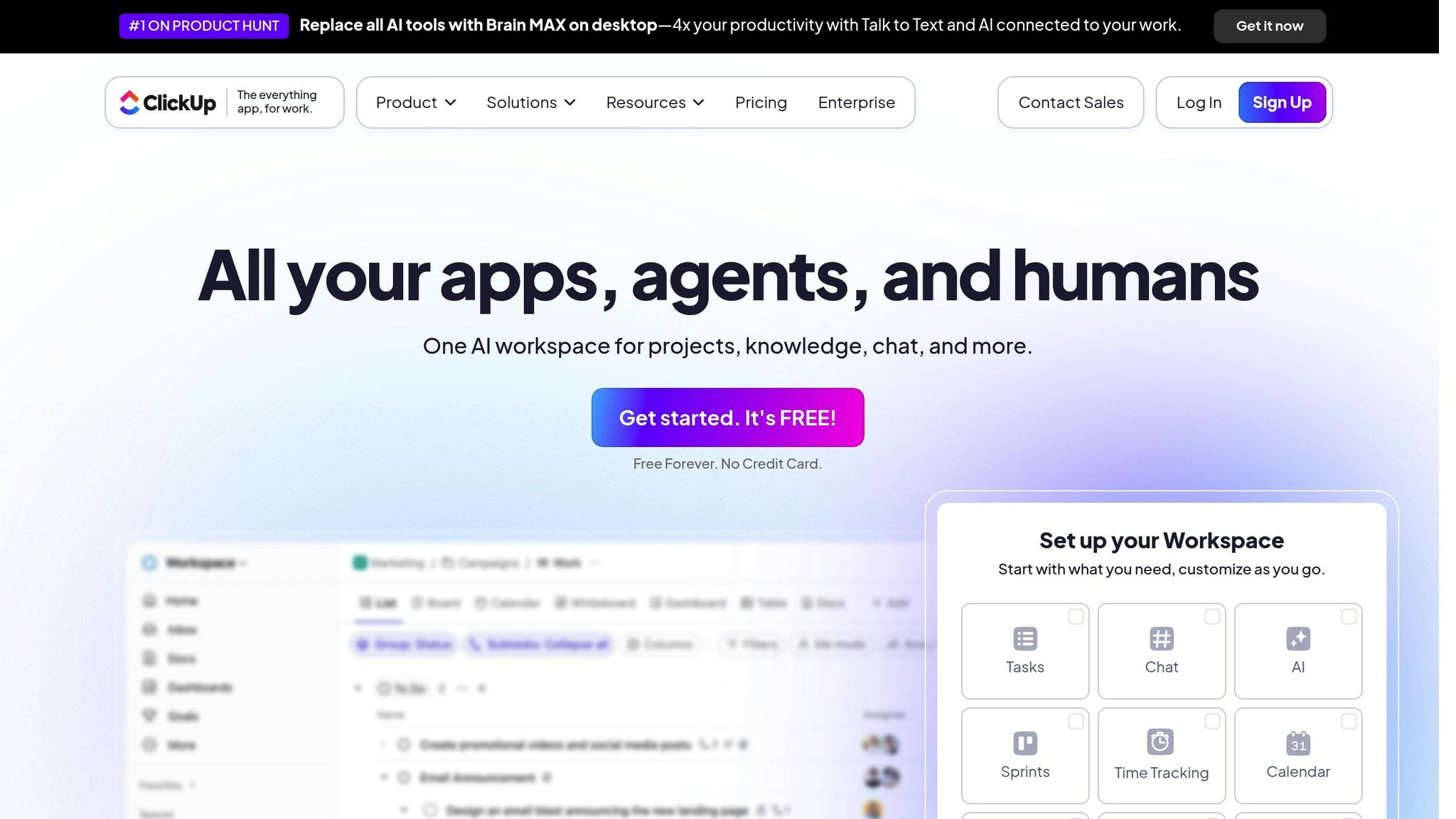
ClickUp is a project management tool that seamlessly incorporates technical debt management into everyday development workflows. While it's widely recognized for offering a robust suite of workspace features, it also provides development teams with a clear framework to identify, document, and prioritize technical debt without disrupting regular project tasks.
Integration with workflows and tools
One of ClickUp's standout features is its ability to embed technical debt tracking into existing workflows. It integrates with popular development tools like GitHub, GitLab, and Bitbucket, enabling teams to create technical debt tasks directly from their code repositories. For instance, if problematic code is flagged during a pull request, a ClickUp task can be instantly generated to document the issue.
Custom fields allow teams to classify technical debt based on factors like severity, effort required, and overall impact. Teams can either set up dedicated sprints to address technical debt or include these items in their regular sprint planning using ClickUp's agile project management tools. This approach ensures that technical debt remains visible and manageable, sitting alongside tasks like feature development and bug fixes. By keeping everything in one place, ClickUp eliminates the need for separate tracking systems and sets the stage for advanced automation.
AI-powered features for prioritization and automation
ClickUp leverages AI to help teams make smarter decisions about technical debt. The AI analyzes task data to suggest which items should be tackled first, considering factors like code complexity, how often the affected areas are updated, and the potential impact on system performance.
Automation takes things a step further by streamlining task management. Tasks can be automatically assigned based on code ownership or expertise, while workflows are triggered to notify team members, update backlogs, and schedule regular reviews. Additionally, ClickUp's time tracking tools allow teams to monitor the effort spent on addressing technical debt compared to initial estimates. This not only helps refine future planning but also provides valuable insights to stakeholders about the business impact of resolving technical debt.
2. SonarQube
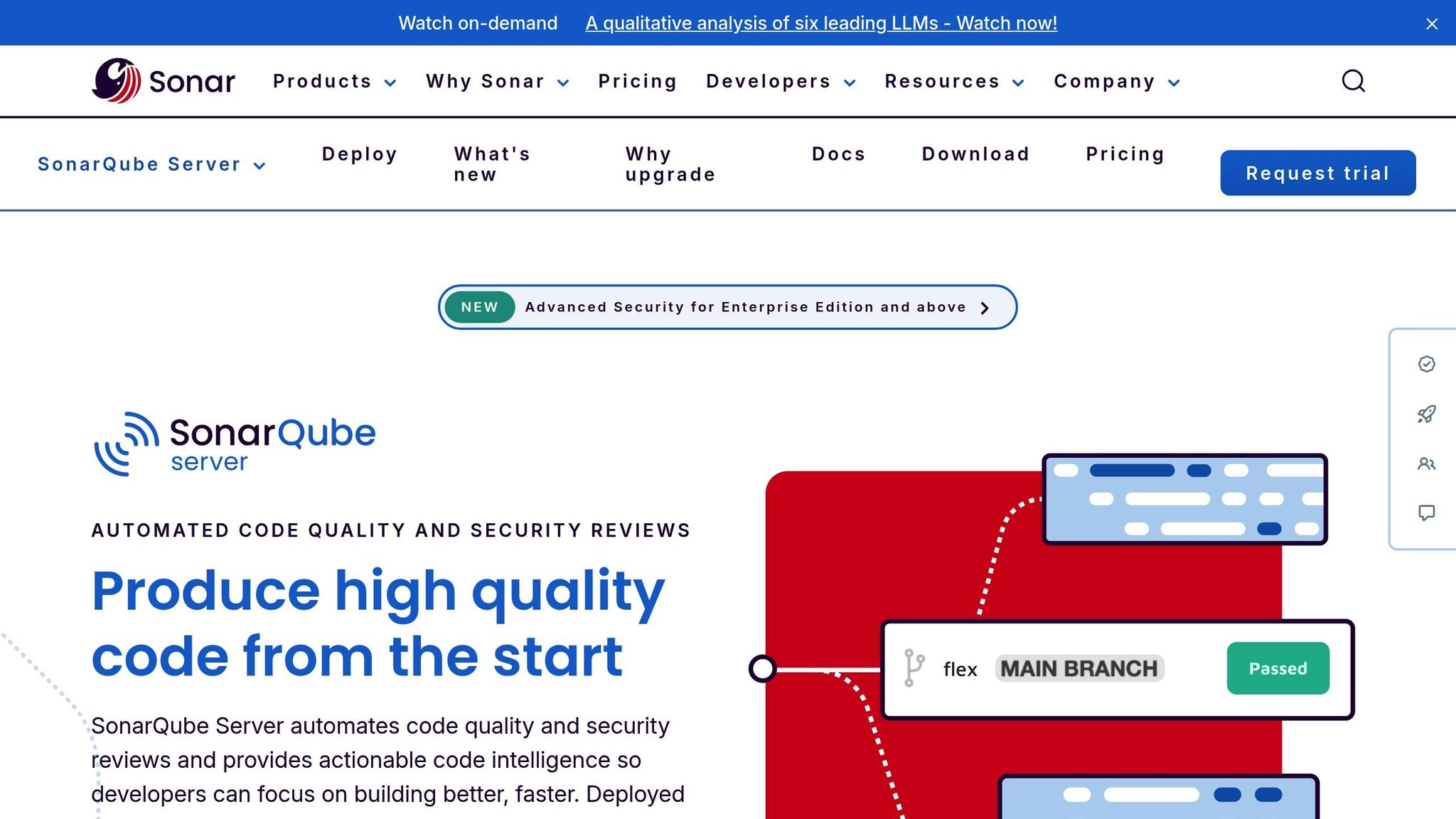
SonarQube is a static code analysis platform designed to measure and manage technical debt. Unlike project management tools that treat technical debt as tasks, SonarQube dives into your actual codebase to identify issues like code smells, duplications, security vulnerabilities, and maintainability concerns. It integrates technical debt analysis directly into your development tools, offering insights based on real-time code analysis.
Static Code Analysis and Technical Debt Metrics
SonarQube excels at providing clear metrics for technical debt. It calculates debt in time units, estimating how long it would take to resolve identified issues. For instance, it might highlight 2.5 days of technical debt in a project.
The platform also introduces a technical debt ratio, comparing the effort required to fix issues against the effort needed to develop the application from scratch. This ratio helps teams gauge whether their codebase is improving or becoming harder to maintain. With quality gates, SonarQube can even halt builds if new code introduces excessive technical debt, ensuring standards are upheld.
One standout feature is its ability to differentiate between old debt and new debt. This allows teams to focus on stopping new issues from creeping in while gradually addressing legacy problems, ensuring long-term improvements in code quality.
Seamless Integration with Workflows and Tools
SonarQube fits smoothly into CI/CD pipelines, offering plugins for Jenkins, Azure DevOps, GitLab CI, and GitHub Actions. It also connects with popular IDEs like IntelliJ IDEA, Visual Studio, and VS Code through SonarLint, providing real-time feedback as developers write code. This means potential technical debt can be addressed immediately, rather than waiting for code reviews to uncover problems.
For project management, SonarQube can export identified issues to tools like Jira, creating tickets for technical debt items. This ensures that technical debt is part of sprint planning and aligns code analysis with broader project goals.
Multi-Language Support and Scalability
SonarQube supports over 25 programming languages, including Java, C#, Python, JavaScript, TypeScript, Go, and Kotlin. This makes it a go-to solution for organizations with diverse tech stacks, as it allows teams to manage technical debt across all projects from a single platform.
The platform scales effortlessly, catering to both small teams and large enterprises. The Community Edition is ideal for smaller projects, while the Enterprise Edition offers advanced capabilities like branch analysis, portfolio management, and executive-level reporting. With the ability to analyse millions of lines of code across hundreds of projects, SonarQube provides comprehensive dashboards that give visibility into technical debt at both project and portfolio levels.
SonarQube also offers quality profiles, enabling teams to customise rules based on their coding standards and technical debt tolerance. This flexibility allows different teams within an organisation to maintain their own quality benchmarks while ensuring consistent reporting to leadership on overall technical debt trends. Next, we’ll look at another tool that integrates technical debt management directly into development workflows.
3. CodeScene

While tools like ClickUp and SonarQube focus on static analysis and task tracking, CodeScene takes a unique approach by incorporating behavioural analysis to offer deeper insights into technical debt. By combining static code analysis with patterns of developer activity, CodeScene provides a more dynamic and actionable perspective on code health.
Static Code Analysis and Technical Debt Metrics
At the heart of CodeScene is its CodeHealth™ metric, which evaluates over 25 code factors to measure quality and technical debt, delivering highly accurate benchmark F-scores [1][5].
What sets CodeScene apart is its ability to identify hotspots - areas where frequent activity overlaps with poor code quality. These hotspots, though representing just 2–3% of a codebase, often account for a disproportionate number of commits and defects [2]. To make this information accessible, CodeScene uses hotspot maps with a simple, intuitive color scheme: green for healthy code, yellow for caution, and red for critical issues [2][3][5]. This visualisation makes it easy for both developers and leadership to spot problem areas and track progress over time.
AI-Powered Features for Prioritization and Automation
CodeScene leverages machine learning to prioritise technical debt based on real-world development patterns. This ensures refactoring efforts are concentrated on the most active and impactful areas of the codebase [2][3].
Why does this matter? Unhealthy code is linked to 15 times more defects, twice the development time, and 10 times more delivery uncertainty compared to healthy code [1]. By addressing these high-priority hotspots, teams can significantly improve efficiency and reduce risks with targeted efforts.
To prevent the accumulation of new technical debt, CodeScene offers real-time feedback through IDE extensions and automated quality gates [1][4]. These tools provide developers with immediate insights as they code, helping maintain high standards across the board.
Integration with Workflows and Tools
CodeScene integrates seamlessly with existing development workflows and tools, making it an effective addition to any technical debt management strategy. For example, it fits directly into CI/CD pipelines, acting as a quality gate to ensure code changes meet predefined standards. Teams can even specify in pull requests that updates to hotspots must maintain or improve code health [5].
In addition, CodeScene can analyse millions of lines of code in seconds, giving technical leaders a clear view of critical areas and enabling them to track progress against refactoring goals [1].
Multi-Language Support and Scalability
CodeScene supports over 25 programming languages, making it ideal for organisations with diverse tech stacks [1]. Its scalability allows it to serve teams of all sizes, from small groups to enterprise-level operations. The platform's dashboards provide a comprehensive view of technical debt, whether at the project level or across an entire portfolio.
With research showing that fixing issues in low-quality code takes 124% more development time [5], CodeScene's targeted approach helps teams save time and improve overall code quality.
4. Stepsize & Stepsize AI
Stepsize changes the way technical debt is tracked by directly linking it to the code and its business context. Instead of drowning teams in endless metrics, it allows developers to log technical debt as they encounter it, tying it to the specific sections of code and business areas where it has the most impact. This approach ensures that technical debt is not just identified but connected to its real-world consequences.
Integration with Workflows and Tools
Stepsize integrates seamlessly into a developer's daily routine. Through IDE extensions and connections with tools like GitHub, GitLab, Jira, and Slack, it ties technical debt directly to specific lines of code, pull requests, and business goals. This makes it easy for developers to address debt as they work, without needing to switch contexts.
During code reviews and sprint planning, Stepsize highlights technical debt in the relevant parts of the codebase. This feature enables teams to decide whether to tackle the debt immediately or plan it for later, keeping the process aligned with ongoing development. By embedding technical debt management into everyday workflows, Stepsize ensures that it becomes a continuous and natural part of the development process.
AI-Powered Features for Prioritization and Automation
Stepsize AI takes things a step further by using machine learning to categorise and prioritise technical debt based on its context within the code and its potential business impact. The AI analyzes patterns in team behavior and project workflows to predict which debt items are likely to affect future work the most.
This predictive insight helps engineering leaders and CTOs allocate resources more effectively, focusing on debt that could slow down upcoming projects rather than theoretical improvements. Additionally, Stepsize AI offers automated debt aging analysis, flagging outdated or irrelevant debt items to keep backlogs clean and aligned with current business priorities.
Multi-Language Support and Scalability
Stepsize is built to support teams working across multiple programming languages, including JavaScript, Python, Java, and C#. Its language-agnostic approach ensures that teams can maintain consistent debt management practices, no matter the diversity of their codebases.
For growing organizations, Stepsize provides portfolio-level visibility, giving engineering leaders insights into technical debt trends across various projects and teams. This bird’s-eye view helps identify recurring issues and informs strategic decisions about where to invest resources. The platform also includes team-based permissions and workflows, ensuring that debt information is actionable for developers while still giving leadership the insights they need for planning and resource allocation.
sbb-itb-fe42743
5. Jira + Debtdash
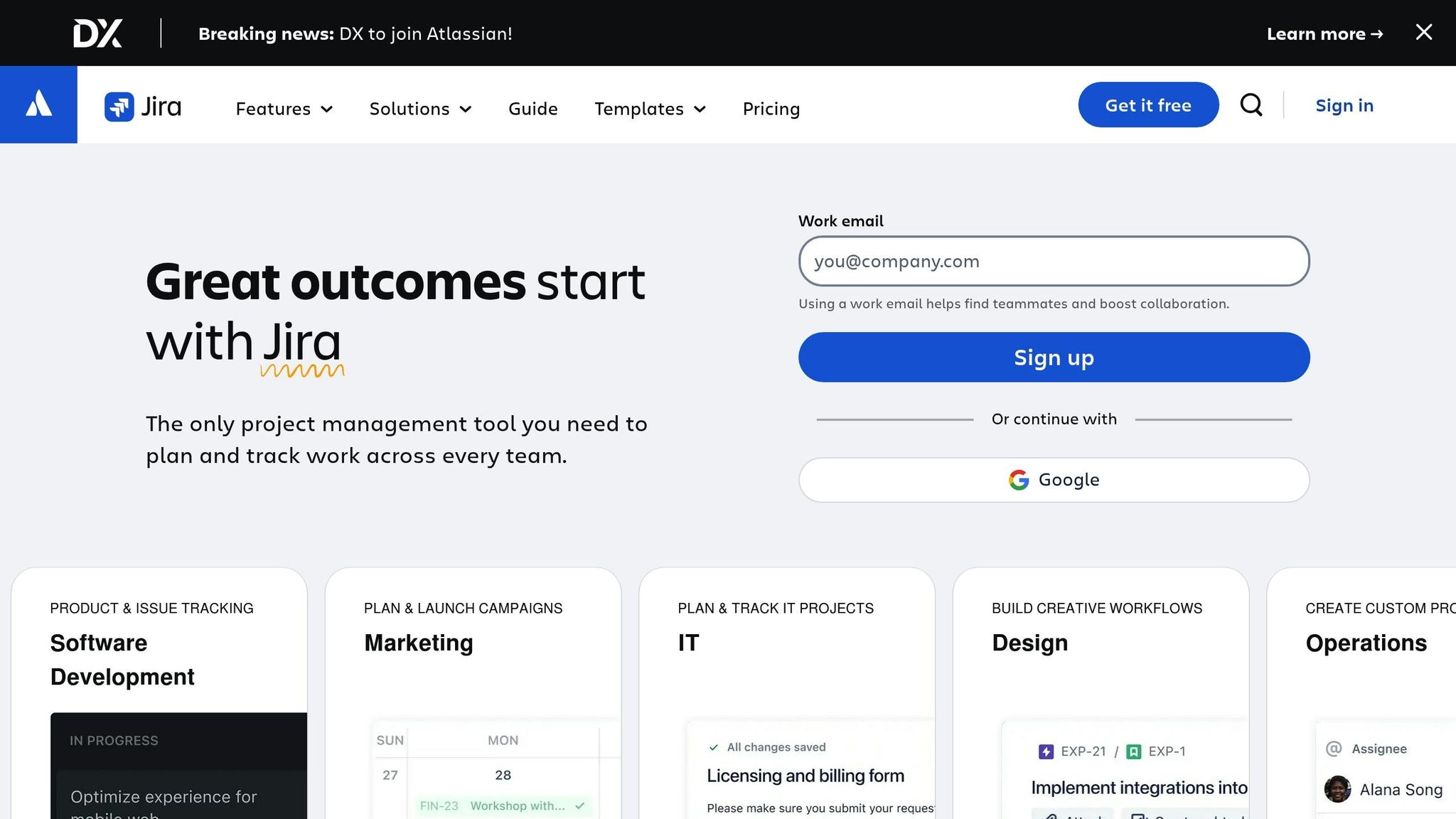
Pairing Jira with Debtdash offers a streamlined way for existing Jira users to manage technical debt without disrupting their current workflows. By combining Jira’s robust project management tools with Debtdash’s debt-specific features, this integration allows teams to track and address technical debt alongside their regular development tasks - all within a single platform.
Debtdash adds specialised functionality to Jira for an extra $1.50 per user per month, on top of Jira's $7.75 per user per month cost[6]. This makes it an affordable choice for teams looking to manage technical debt without overhauling their project management setup. It’s a practical solution that embeds debt tracking directly into the tools teams already use.
Integration with Workflows and Tools
The Jira + Debtdash setup fits seamlessly into existing workflows, especially for teams operating within agile frameworks. Teams can customise issue types in Jira to flag technical debt, turning standard tasks into debt-specific items like outdated libraries, overly complex code, or structural issues. These debt items can then be integrated into sprint planning, allowing teams to allocate story points and track progress on debt resolution alongside feature development.
Debtdash enhances this process with intuitive dashboards that transform Jira’s raw data into actionable insights. These dashboards provide unified reporting, combining technical debt metrics with standard project tracking. Teams can monitor trends over time, measure resolution rates, and pinpoint recurring patterns in how debt builds up across projects or contributors.
By using the same prioritisation frameworks applied to user stories and bugs, teams can make well-informed decisions about balancing debt reduction with feature delivery. This approach ensures that technical debt doesn’t take a backseat but becomes an integral part of the development lifecycle.
Multi-Language Support and Scalability
While this integration works well for many teams, it’s important to consider its scalability and limitations. Jira is highly capable of managing workflows at an enterprise level, but the Jira + Debtdash combination relies on manual input for identifying technical debt. This means developers must actively log debt items during their work, which can be a challenge for larger teams or organisations managing diverse codebases and multiple programming languages.
For smaller teams or those with disciplined processes, this manual approach can be effective. However, for larger enterprises, the lack of automated debt detection may lead to gaps in tracking. Unlike automated code analysis tools, this system doesn’t scan codebases to identify potential debt, which can result in inconsistent data across projects.
To address this, teams can consider integrating automated code analysis tools alongside the Jira + Debtdash setup. This hybrid approach leverages Jira’s workflow integration while using automated tools to identify and quantify technical debt across various programming languages, providing a more comprehensive solution.
"I've seen far more ROI in targeting high-impact technical debt than in blanket code refactoring. The 80/20 Rule forces you to think strategically, not reactively." - Pedro Souto, Vice President of Product, Rydoo[7]
The real strength of this platform lies in its ability to keep technical debt front and center, ensuring it’s treated as a priority rather than an afterthought. By embedding debt tracking into everyday workflows, teams can prevent it from being sidelined and continuously deprioritised.
6. CAST Highlight
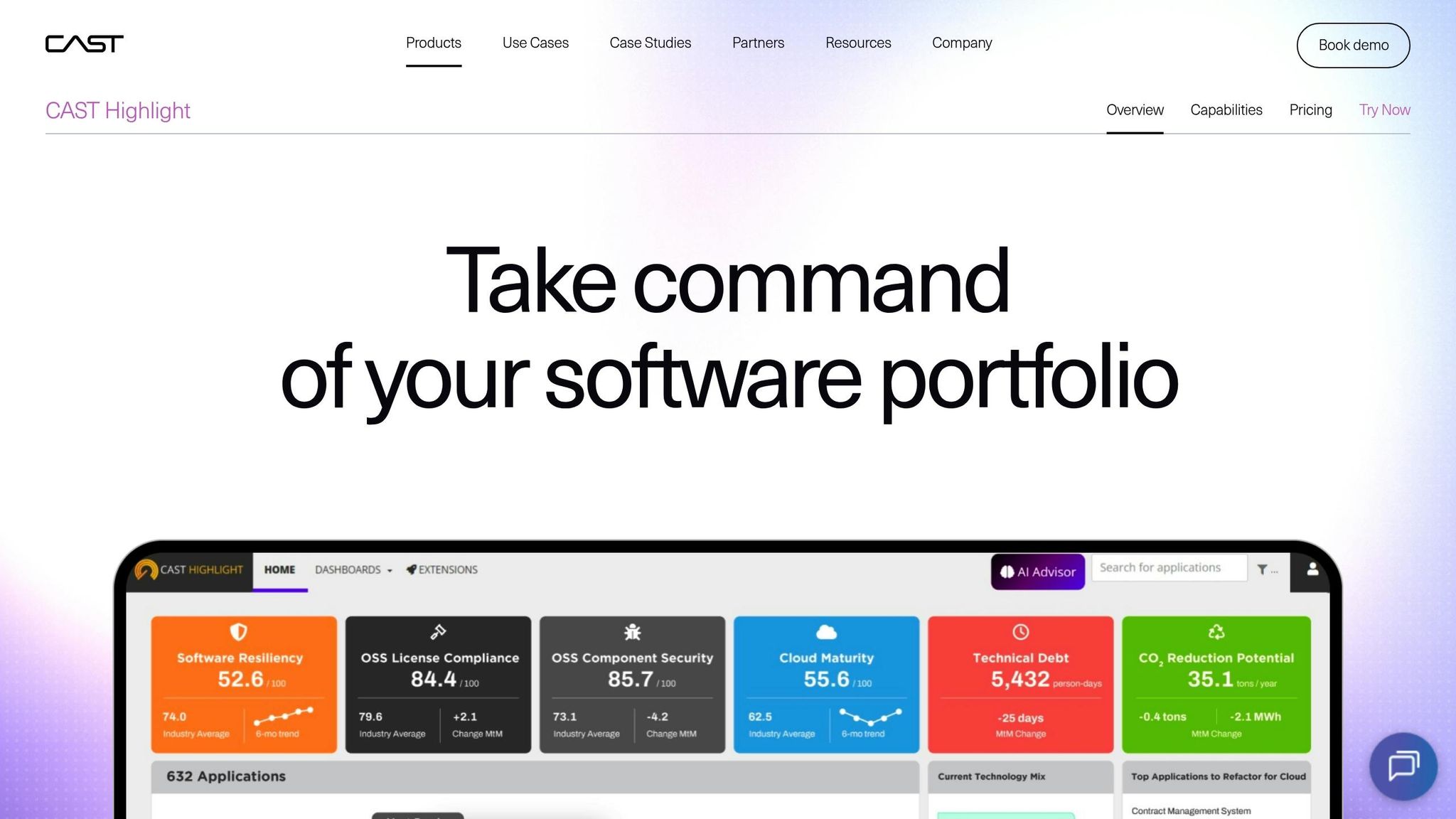
CAST Highlight simplifies the process of monitoring technical debt by automating source code scans and delivering key metrics. For CTOs and engineering leaders juggling complex codebases, it offers practical insights to support modernization efforts and cloud migration strategies.
Key Metrics and Technical Debt Assessment
With CAST Highlight, important metrics are automatically extracted from source code scans. It provides health factor scores and flags potential cloud-related obstacles that could hinder modernization projects.
Integration with Workflows and Tools
CAST Highlight is designed to fit seamlessly into development workflows. It includes a CLI tool that automates code scanning and uploading, making it easy to integrate into CI/CD pipelines. The platform also features a public REST API, allowing teams to pull technical metrics and embed them into existing project management or reporting systems. Additionally, it connects with popular tools such as MEGA, Alphabet, Azure DevOps, and Atlassian Jira. It supports importing Software Bill of Materials (SBOMs) in CycloneDX format and offers Docker images and a Docker CLI for analysing containerized applications.
Multi-Language Support and Scalability
CAST Highlight supports over 50 programming languages and more than 12 database types, making it ideal for organizations with varied tech stacks. Its scalable architecture can handle large applications, offering technical debt metrics across entire codebases. This broad coverage provides leadership with a detailed view of their technical environment, helping them make informed decisions about modernization and ongoing maintenance.
7. CodeAnt.ai
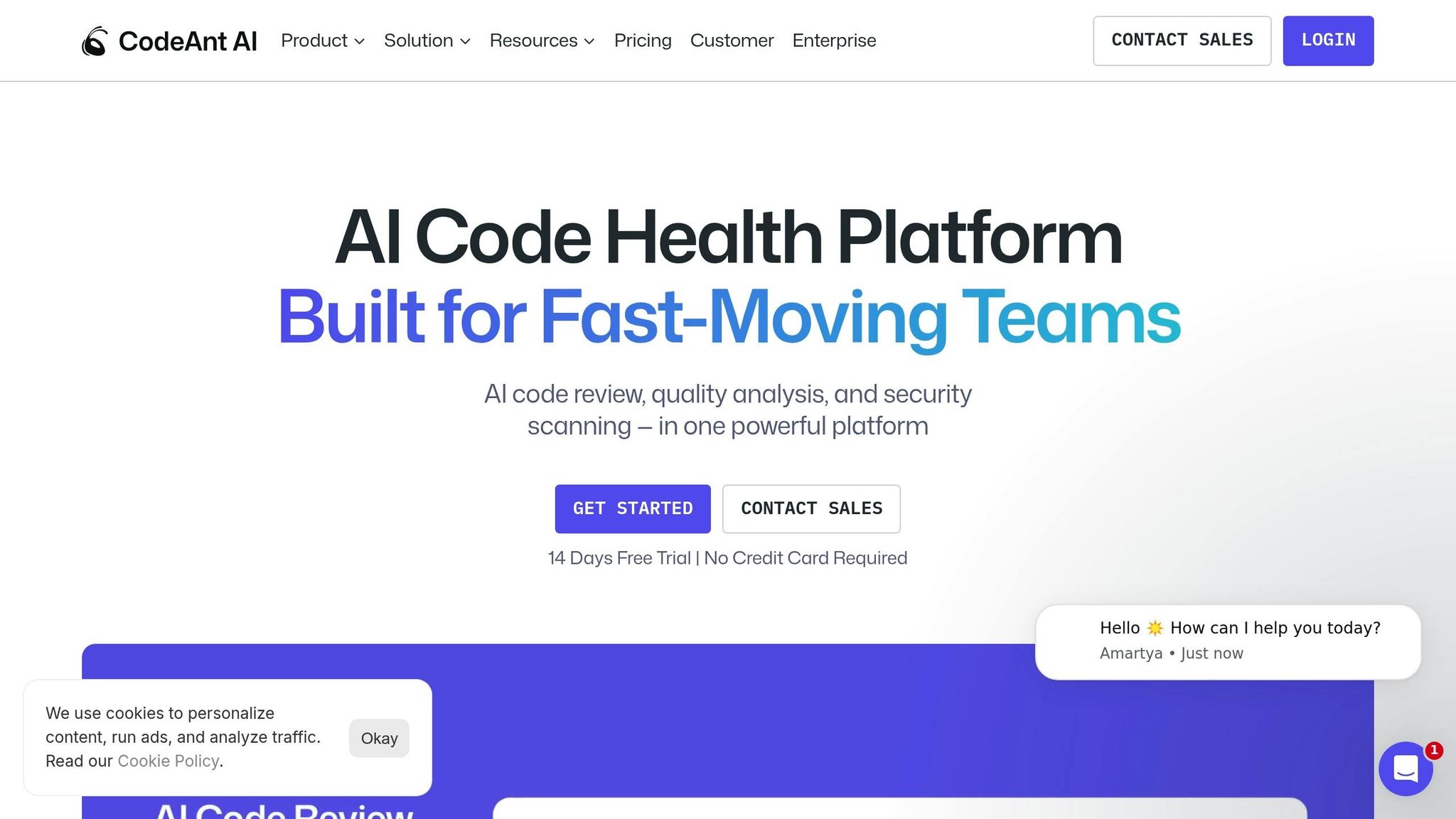
CodeAnt.ai leverages static code analysis to scan code commits, identifying quality issues, security vulnerabilities, and unused code. By catching these problems early in the development process, it helps teams maintain high code standards and avoid potential pitfalls. This early intervention plays a key role in managing technical debt effectively.
Impressively, CodeAnt.ai addresses over 5,000 issues, including duplicate code, with a high degree of accuracy[8]. By focusing on early problem detection, it enables development teams to tackle technical debt before it becomes overwhelming.
Tool Comparison Table
Choosing the right tool depends on your team size, budget, and tech stack. Below is a detailed comparison of seven tools to help you make the best choice for your needs.
| Tool | Static Analysis | AI Capabilities | IDE Integration | Supported Languages | Pricing (USD) | Best For |
|---|---|---|---|---|---|---|
| ClickUp | Limited | Basic automation | VS Code, others | N/A (project management) | $7-$19/user/month | Teams needing project management with debt tracking |
| SonarQube | Comprehensive | Rule-based analysis | IntelliJ, VS Code, Eclipse | 25+ languages | Free Community, $150/month Developer | Code quality and security analysis |
| CodeScene | Advanced | Behavioral analysis | Visual Studio, IntelliJ | Java, C#, Python, JavaScript | $15-$39/developer/month | Understanding code complexity and hotspots |
| Stepsize & Stepsize AI | Moderate | AI-powered insights | VS Code, IntelliJ | Multiple languages | $10-$25/developer/month | Contextual debt documentation |
| Jira + Debtdash | Via integrations | Limited | Through Jira plugins | N/A (issue tracking) | $7.50-$14.50/user/month + Debtdash costs | Agile teams using Atlassian ecosystem |
| CAST Highlight | Enterprise-level | Risk assessment AI | Limited | 40+ technologies | Custom enterprise pricing | Large organizations needing portfolio analysis |
| CodeAnt.ai | Comprehensive | Advanced detection | Multiple IDEs | 25+ languages | Contact for pricing | Early problem detection and prevention |
When deciding, consider your team's specific needs. For smaller teams requiring basic debt tracking alongside project management, ClickUp is a solid choice. On the other hand, SonarQube's free Community edition is a great option for open-source projects, offering robust code quality and security analysis.
Enterprise teams might find CAST Highlight worth its investment for in-depth portfolio analysis. If your focus is on understanding code behaviour and identifying hotspots, CodeScene is a standout option. Meanwhile, CodeAnt.ai is ideal for teams aiming to catch issues early and prevent technical debt.
For teams already using the Atlassian ecosystem, the Jira + Debtdash combination integrates seamlessly into existing workflows. Pricing varies widely - some tools offer transparent per-user rates, while others require custom quotes. Carefully evaluate these factors to align with your team’s priorities and streamline your approach to managing technical debt effectively.
Conclusion
Tackling technical debt effectively comes down to having the right tools and a clear strategy. The tools we've discussed each bring something unique to the table - whether it's ClickUp's project management capabilities, SonarQube's detailed code analysis, CodeScene's behavioural insights, or CAST Highlight's enterprise-level portfolio evaluation.
Each organisation's needs will vary, so it's essential to select a tool that aligns with your team's size, tech stack, and workflow. Smaller teams might lean towards tools with less overhead, while larger organisations could benefit from more comprehensive solutions like CAST Highlight. Consider factors like pricing, scalability, and how well a tool integrates with your current systems. For instance, if your team already uses Atlassian products, combining Jira with Debtdash offers a seamless integration. On the other hand, CodeScene's behavioural analysis can provide deeper insights into code complexity, going beyond traditional static assessments.
Managing technical debt isn't just about picking the right tool - it also requires a solid plan, proper implementation, and regular reviews. Many CTOs find that expert guidance during the selection and implementation process can save time and help avoid costly mistakes. Starting with one well-suited solution and scaling as your team grows is often the best approach.
For organisations seeking strategic technical leadership, Metamindz offers fractional CTO services for $2,750 per month. Their team of experts can assist with everything from choosing the right tools and creating implementation strategies to managing long-term technical debt and conducting due-diligence assessments.
The key is to begin with a solution that fits your current needs. With the right tool and expert guidance, your organisation can build a strong foundation for managing technical debt effectively.
FAQs
What’s the best way to choose a tool for tracking technical debt based on my team’s size and budget?
When it comes to tracking technical debt, the ideal tool will vary based on your team's size, budget, and unique requirements. For smaller teams working with limited resources, focus on tools that are affordable, straightforward to integrate, and offer the key metrics you need without unnecessary complexity. On the other hand, larger teams or organizations with more funding might find value in advanced platforms that provide detailed analytics and seamless integration with existing systems.
As you evaluate options, think about how well a tool fits into your current development workflows, whether it can grow alongside your team, and if it brings clear, measurable benefits. The best choice should address your immediate priorities while also aligning with your long-term objectives.
Why should technical debt management be integrated into development workflows?
Managing technical debt as part of your development process allows teams to spot and tackle problems early. This not only reduces manual work but also maintains consistent code quality with the help of automation tools like code analyzers and automated testing.
By addressing technical debt proactively, you can accelerate product development, lower long-term expenses, and improve your team's ability to adapt quickly to market shifts. Over time, this strategy ensures your software stays scalable, efficient, and ready to support ongoing growth.
How can AI help identify and prioritize technical debt more effectively?
AI offers a practical way to tackle technical debt by examining elements like code complexity, defect density, and outdated systems to assess their effect on software performance. It can take over repetitive tasks such as code reviews, refactoring, and testing, which not only saves time but also allows development teams to concentrate on more pressing priorities.
On top of that, AI aids in prioritizing technical debt by connecting it to business objectives, incorporating it into sprint planning, and identifying high-risk components through patterns like frequent bugs or tangled dependencies. This data-driven strategy empowers teams to make smarter decisions, helping them address technical debt in a more effective and manageable way.
